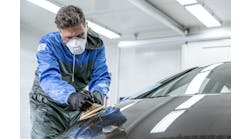This industry changes, fast—and how shops operate in 2022 would be almost unrecognizable a decade ago. But while technology and operations have advanced, some things have stayed frozen in time; one being how the cost of paint and material for a repair is calculated and billed.
According to Tim Ronak, senior services consultant at AkzoNobel, shops are losing money by billing for material using the set rate per unit. FenderBender sat down with Ronak to speak more on how changing your process of itemizing material cost can help grow your business.
Why is recouping the price of paint vital to shop owners?
It is important to look at how you can recoup all of the costs needed for a repair, not just paint. The cost of raw materials can be anywhere from three to five percent of the total sales number.
And the challenge is that we currently have some very antiquated ways that these materials are being approximated as a sales amount.
There are some owners out there who choose to use a specified amount multiplied by the number of refinish units within a repair as a way to approximate the material cost reimbursement. Over time, this method has become woefully inadequate. In most examples, the cost of some of the toners and mica that go into the colors have resulted in liquid costs that are far more expensive than the material cost being allotted. And these material reimbursements per refinish unit vary state to state—which doesn’t make much sense. Because of this, many shops are moving away from this rate per unit method, and instead, creating an invoice for the materials that they're actually using for each repair.
How can shops go about billing for the actual cost of material?
Owners can utilize several technologies to determine the cost of material per repair. Most major paint manufacturers have a system to be able to invoice for the actual liquid materials that go on a vehicle. But more than the cost of the paint, are the allied materials that are needed for a repair. Things like masking tapes, sandpaper, seam sealer, stir sticks, mixing cups, and other additional supplementary materials needed beyond paint materials should also be taken into account when calculating cost.
There are some really great tools that can be used to capture accurate liquid and allied material cost. PMCLogic is a good tool for calculating cost per repair, as well as the Mitchell Refinishing Material Calculator (RMC).
PMCLogic looks at what you are doing for refinish hours, and then breaks down cost based on your historical consumption of materials in order to determine what you're going to use from an allied material standpoint—along with all of the liquid materials.
Do owners need to do anything differently once they switch their material cost strategy?
We’ve used this dollar amount per refinish hour for such a long time that creating a material cost invoice only becomes an issue when insurers are looking to reimburse. The insurers use this multiplier rate as a way to limit the material reimbursement. In many cases, the material calculation becomes contentious because the insurer’s threshold that they have set for materials gets exceeded when we actually document all the materials used by an individual facility.
On the other hand, explaining the cost calculation change to a customer is fairly straightforward by showing the breakdown of materials.
What do you say to shop owners who may be on the fence about switching how they calculate material costs?
We've got technology overload with some of these collision repair centers; between management systems, estimating systems, data acquisition systems, repair procedure systems, marketing systems, and customer management systems—shops are investing a lot in technology. The average shop is probably spending more than $4,000 a month just in software and licensing subscription fees. So before investing in a cost calculator tool, make your own decision on if there is a great return on investment for your shop.
To learn more, visit www.sikkensvr.com/en-us/Services/Business-Services.



